Quantum Dot Nanobeads Based Fluorescence Immunoassay for the Quantitative Detection of Sulfamethazine in Chicken and Milk
Abstract
:1. Introduction
2. Materials and Methods
2.1. Reagents and Materials
2.2. Preparation of QBs
2.3. Preparation and Characterization of QBs-mAb
2.4. Assembling of QBs-LFIA Sensor
2.5. Procedure of QBs-LFIA
2.6. Optimization of the Key Parameters
2.7. Study on Immune Dynamic Response
2.8. Establishment of Standard Calibration Curve in PBS
2.9. Specificity Assessment
2.10. Sample Preparation
2.10.1. Chicken Sample Pretreatment
2.10.2. Milk Sample Pretreatment
2.11. Detection of SMZ in Real Samples
2.11.1. Establishment of Standard Calibration Curve in Real Samples
2.11.2. Recovery of SMZ on the QBs-LFIA System in 2 Food Matrices
2.11.3. Analysis of HPLC
3. Results and Discussion
3.1. Characterization of QBs and QBs-mAb
3.2. Optimization of QBs-LFIA
3.2.1. Optimization of the Coupling pH
3.2.2. Optimization of the Concentration of EDC
3.2.3. Optimization of the Amount of mAb
3.2.4. Optimization of the Concentration of SMZ − BSA on the T Line
3.2.5. Optimization of the Amount of QBs-mAbs Probe
3.2.6. Immune Dynamic Response Analysis of QBs-LFIA
3.2.7. Evaluation of QBs-LFIA
Determination of Detection Limit and Linear Range
Specificity of the QBs-LFIA
Recovery Experiment
3.3. Detection Results of Real Samples
4. Conclusions
Author Contributions
Funding
Institutional Review Board Statement
Informed Consent Statement
Data Availability Statement
Conflicts of Interest
References
- Long, P.H. Introduction of Gerhard Domagk. Ann. N. Y. Acad. Sci. 2010, 69, 379. [Google Scholar] [CrossRef]
- Akocak, S.; Güzel-Akdemir, Ö.; Sanku, R.K.K.; Russom, S.S.; Iorga, B.I.; Supuran, C.T. Pyridinium derivatives of 3-aminobenzenesulfonamide are nanomolar-potent inhibitors of tu-mor-expressed carbonic anhydrase isozymes CA IX and CA XII. Bioorg. Chem. 2020, 103, 104204. [Google Scholar] [CrossRef] [PubMed]
- Lopez Flores, J.; Fernandez de Cordova, M.L.; Molina Diaz, A. Flow-through optosensor combined with pho-tochemically induced fluorescence for simultaneous determination of binary mixtures of sulfonamides in pharma-ceuticals, milk and urine. Anal. Chim. Acta 2007, 600, 164–171. [Google Scholar] [CrossRef] [PubMed]
- Wang, L.; Wang, J.; Wang, J.; Zhu, L.; Yang, L.; Yang, R. Distribution characteristics of antibiotic resistant bacteria and genes in fresh and composted manures of livestock farms. Sci. Total Environ. 2019, 695, 133781. [Google Scholar] [CrossRef]
- Huang, F.; An, Z.; Moran, M.J.; Liu, F. Recognition of typical antibiotic residues in environmental media related to groundwater in China (2009–2019). J. Hazard. Mater. 2020, 399, 122813. [Google Scholar] [CrossRef] [PubMed]
- Peng, D.; Li, Z.; Wang, Y.; Liu, Z.; Sheng, F.; Yuan, Z. Enzyme-linked immunoassay based on imprinted microspheres for the detection of sulfamethazine residue. J. Chromatogr. A 2017, 1506, 9–17. [Google Scholar] [CrossRef] [PubMed]
- Karageorgou, E.; Manousi, N.; Samanidou, V.; Kabir, A.; Furton, K.G. Fabric phase sorptive extraction for the fast isolation of sulfonamides residues from raw milk followed by high performance liquid chromatography with ultraviolet detection. Food Chem. 2016, 196, 428–436. [Google Scholar] [CrossRef]
- Hu, G.; Sheng, W.; Zhang, Y.; Wang, J.; Wu, X.; Wang, S. Upconversion Nanoparticles and Monodispersed Magnetic Polystyrene Microsphere Based Fluo-rescence Immunoassay for the Detection of Sulfaquinoxaline in Animal-Derived Foods. J. Agric. Food Chem. 2016, 64, 3908–3915. [Google Scholar] [CrossRef]
- Wang, Y.; Yan, X.; Kou, Q.; Sun, Q.; Wang, Y.; Wu, P.; Yang, L.; Tang, J.; Le, T. An Ultrasensitive Label-Free Fluorescent Aptasensor Platform for Detection of Sulfamethazine. Int. J. Nanomed. 2021, 16, 2751–2759. [Google Scholar] [CrossRef]
- European Economic Community. Commission Regulation (EC) no. 508/1999. Off. J. Eur. Commun. 1999, L60, 16–52. [Google Scholar]
- Animal Husbandry and Veterinary Bureau of Ministry of Agriculture. Announcement of Ministry of Agriculture maximum residue levels of veterinary drug in foodstuffs of animal origin. Chin. J. Vet. Drug 2003, 4, 15–20. [Google Scholar]
- Li, T.; Wang, C.; Xu, Z.; Chakraborty, A. A coupled method of on-line solid phase extraction with the UHPLC- MS/MS for detection of sulfona-mides antibiotics residues in aquaculture. Chemosphere 2020, 254, 126765. [Google Scholar] [CrossRef] [PubMed]
- Nebot, C.; Regal, P.; Martínez, B.; Miranda, J.; Cepeda, A.; Fente, C. Confirmatory method for nine sulfonamides in miniature bovine muscle samples using HPLC/MS/MS without using SPE. J. Food Drug Anal. 2010, 18, 1. [Google Scholar] [CrossRef]
- Bach, C.; Boiteux, V.; Hemard, J.; Colin, A.; Rosin, C.; Munoz, J.-F.; Dauchy, X. Simultaneous determination of perfluoroalkyl iodides, perfluoroalkane sulfonamides, fluorote-lomer alcohols, fluorotelomer iodides and fluorotelomer acrylates and methacrylates in water and sediments using solid-phase microextraction-gas chromatography/mass spectrometry. J. Chromatogr. A 2016, 1448, 98–106. [Google Scholar]
- Adrian, J.; Pasche, S.; Diserens, J.-M.; Sánchez-Baeza, F.; Gao, H.; Marco, M.-P.; Voirin, G. Waveguide interrogated optical immunosensor (WIOS) for detection of sulfonamide antibiotics in milk. Biosens. Bioelectron. 2009, 24, 3340–3346. [Google Scholar] [CrossRef]
- Xiao, X.; Hu, S.; Lai, X.; Peng, J.; Lai, W. Developmental trend of immunoassays for monitoring hazards in food samples: A review. Trends Food Sci. Technol. 2021, 111, 68–88. [Google Scholar] [CrossRef]
- Yano, K.; Iwasaki, A. Enhancement of Fluorescence-Based Sandwich Immunoassay Using Multilayered Micro-plates Modified with Plasma-Polymerized Films. Sensors 2017, 17, 37. [Google Scholar] [CrossRef] [Green Version]
- He, Z.-X.; Shi, L.-C.; Ran, X.-Y.; Li, W.; Wang, X.-L.; Wang, F.-K. Development of a Lateral Flow Immunoassay for the Rapid Diagnosis of Invasive Candidiasis. Front. Microbiol. 2016, 7, 1451. [Google Scholar] [CrossRef] [Green Version]
- Miočević, O.; Cole, C.R.; Laughlin, M.J.; Buck, R.L.; Slowey, P.D.; Shirtcliff, E.A. Quantitative Lateral Flow Assays for Salivary Biomarker Assessment: A Review. Front. Public Health 2017, 5, 133. [Google Scholar] [CrossRef] [Green Version]
- Hu, L.-M.; Luo, K.; Xia, J.; Xu, G.-M.; Wu, C.-H.; Han, J.-J.; Zhang, G.-G.; Liu, M.; Lai, W.-H. Advantages of time-resolved fluorescent nanobeads compared with fluorescent submicrospheres, quantum dots, and colloidal gold as label in lateral flow assays for detection of ractopamine. Biosens. Bioelectron. 2017, 91, 95–103. [Google Scholar] [CrossRef]
- Hu, G.; Gao, S.; Han, X.; Yang, L. Comparison of Immunochromatographic Strips Using Colloidal Gold, Quantum Dots, and Upcon-version Nanoparticles for Visual Detection of Norfloxacin in Milk Samples. Food Anal. Methods 2020, 13, 1069–1077. [Google Scholar] [CrossRef]
- Serebrennikova, K.; Samsonova, J.; Osipov, A. Hierarchical Nanogold Labels to Improve the Sensitivity of Lat-eral Flow Immunoassay. Nano-Micro Lett. 2018, 10, 24. [Google Scholar] [CrossRef] [Green Version]
- Liu, F.; Zhang, H.; Wu, Z.; Dong, H.; Zhou, L.; Yang, D.; Ge, Y.; Jia, C.; Liu, H.; Jin, Q.; et al. Highly sensitive and selective lateral flow immunoassay based on magnetic nanoparticles for quantitative detection of carcinoembryonic antigen. Talanta 2016, 161, 205–210. [Google Scholar] [CrossRef] [Green Version]
- Su, L.; Wang, L.; Yao, X.; Yin, X.; Zhang, H.; Zhao, M.; Liu, S.; Wang, Z.; Wang, J.; Zhang, D. Small size nanoparti-cles-Co3O4 based lateral flow immunoassay biosensor for highly sensitive and rapid detection of furazolidone. Talanta 2020, 211, 120729. [Google Scholar] [CrossRef] [PubMed]
- Shim, W.-B.; Kim, J.-S.; Kim, M.-G.; Chung, D.-H. Rapid and Sensitive Immunochromatographic Strip for On-site Detection of Sulfamethazine in Meats and Eggs. J. Food Sci. 2013, 78, M1575–M1581. [Google Scholar] [CrossRef]
- O’Keeffe, M.; Crabbe, P.; Salden, M.; Wichers, J.; Van Peteghem, C.; Kohen, F.; Pieraccini, G.; Moneti, G. Preliminary evaluation of a lateral flow immunoassay device for screening urine samples for the presence of sulphamethazine. J. Immunol. Methods 2003, 278, 117–126. [Google Scholar] [CrossRef]
- Wang, Z.; Xing, K.; Ding, N.; Wang, S.; Zhang, G.; Lai, W. Lateral flow immunoassay based on dual spectral-overlapped fluorescence quenching of polydopamine nanospheres for sensitive detection of sulfamethazine. J. Hazard. Mater. 2021, 423 Pt B, 127204. [Google Scholar] [CrossRef]
- Bai, Z.; Wei, H.; Yang, X.; Zhu, Y.; Peng, Y.; Yang, J.; Wang, C.; Rong, Z.; Wang, S. Rapid Enrichment and Ultrasensitive Detection of Influenza A Virus in Human Specimen using Magnetic Quantum Dot Nanobeads Based Test Strips. Sens. Actuators B Chem. 2020, 325, 128780. [Google Scholar] [CrossRef] [PubMed]
- Zhou, S.; Peng, Y.; Hu, J.; Duan, H.; Ma, T.; Hou, L.; Li, X.; Xiong, Y. Quantum dot nanobead-based immunochromatographic assay for the quantitative detection of the procalcitonin antigen in serum samples. Microchem. J. 2020, 159, 105533. [Google Scholar] [CrossRef]
- Duan, H.; Huang, X.; Shao, Y.; Zheng, L.; Guo, L.; Xiong, Y. Size-Dependent Immunochromatographic Assay with Quantum Dot Nanobeads for Sensitive and Quantitative Detection of Ochratoxin A in Corn. Anal. Chem. 2017, 89, 7062–7068. [Google Scholar] [CrossRef]
- Ren, M.; Xu, H.; Huang, X.; Kuang, M.; Xiong, Y.; Xu, H.; Xu, Y.; Chen, H.; Wang, A. Immunochromatographic Assay for Ultrasensitive Detection of Aflatoxin B1 in Maize by Highly Luminescent Quantum Dot Beads. ACS Appl. Mater. Interfaces 2014, 6, 14215–14222. [Google Scholar] [CrossRef] [Green Version]
- Zhang, Y.; Peng, J.; Guo, P.; Li, G.-Q.; Zhang, K.-Y.; Lv, X.; Lai, W.-H. Matrix effect of swine urine on time-resolved fluorescent nanobeads and colloidal gold immunochromatographic assay. Food Agric. Immunol. 2018, 29, 711–721. [Google Scholar] [CrossRef] [Green Version]
- Su, S.; Zhang, M.; Li, B.; Zhang, H.; Dong, X. HPLC determination of sulfamethazine in milk using surface-imprinted silica synthesized with ini-ferter technique. Talanta 2008, 76, 1141–1146. [Google Scholar] [CrossRef]
- Putri, L.K.; Ng, B.J.; Ong, W.J.; Lee, H.W.; Chang, W.S.; Mohamed, A.R.; Chai, S.P. Energy level tuning of CdSe colloidal quantum dots in ternary 0D-2D-2D CdSe QD/B-rGO/O-gC3N4 as photocatalysts for enhanced hydrogen generation. Appl. Catal. B Environ. 2020, 265, 118592. [Google Scholar] [CrossRef]
- Ratnesh, R.; Mehata, M.S. Investigation of biocompatible and protein sensitive highly luminescent quantum dots/nanocrystals of CdSe, CdSe/ZnS and CdSe/CdS. Spectrochim. Acta Part A Mol. Biomol. Spectrosc. 2017, 179, 201–210. [Google Scholar] [CrossRef]
- Feng, K.; Xue, W.; Hu, X.; Fan, J.; Liu, E. Z-scheme CdSe/ZnSe heterojunction for efficient photocatalytic hydrogen evolution. Colloids Surf. A Physicochem. Eng. Asp. 2021, 622, 126633. [Google Scholar] [CrossRef]
- Jin, B.; Kong, S.; Zhang, G.; Chen, X.; Ni, H.; Zhang, F.; Wang, D.; Zeng, J. Voltage-assisted SILAR deposition of CdSe quantum dots to construct a high performance of ZnS/CdSe/ZnS quantum dot-sensitized solar cells. J. Colloid Interface Sci. 2020, 586, 640–646. [Google Scholar] [CrossRef]
- Wang, Z.-H.; Zhang, S.-X.; Shen, J.-Z.; Sergei, A.E. Analysis of Sulfamethazine by Fluorescence Polarization Immunoassay. Chin. J. Anal. Chem. 2007, 35, 819–824. [Google Scholar] [CrossRef]
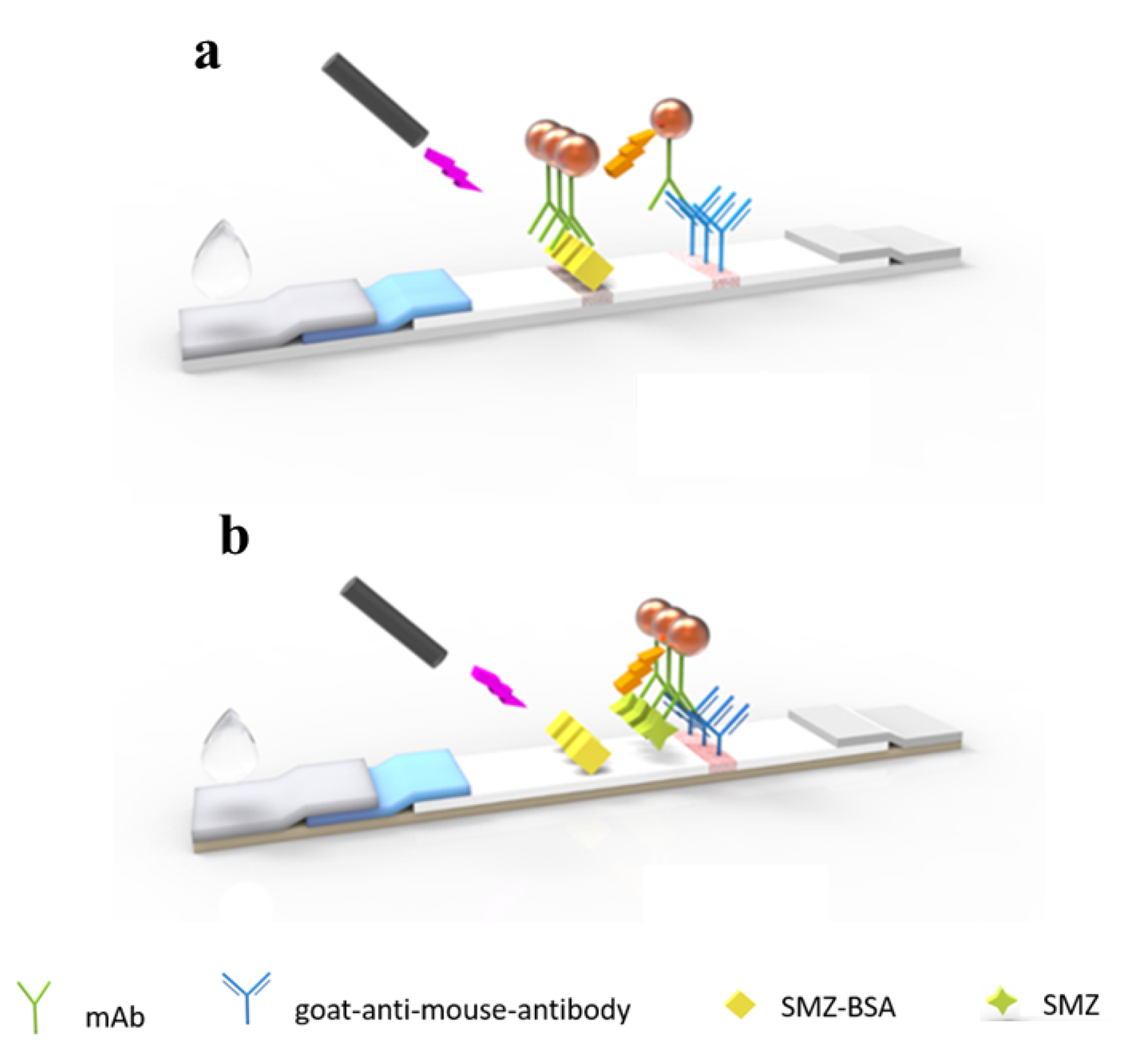
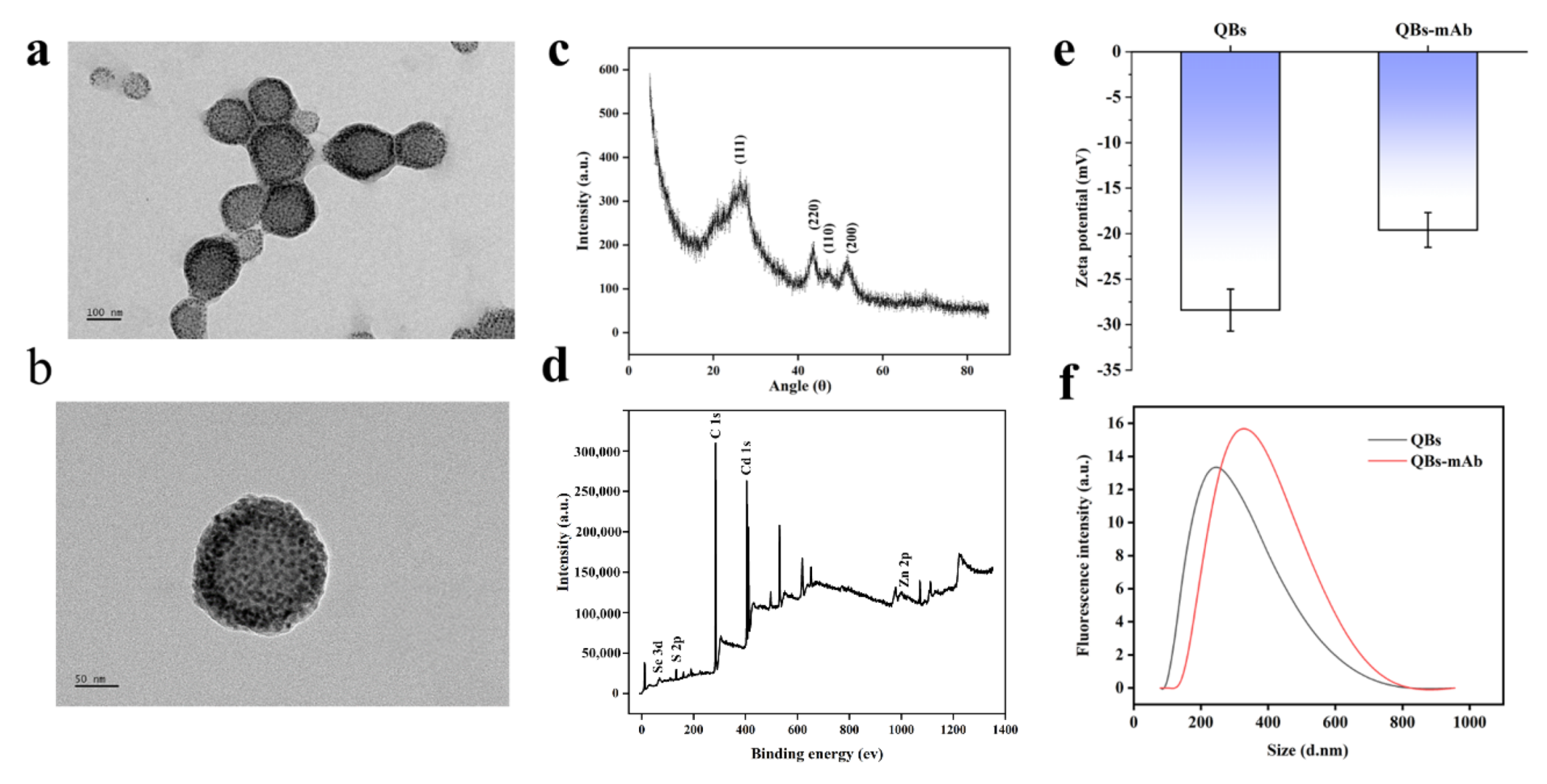
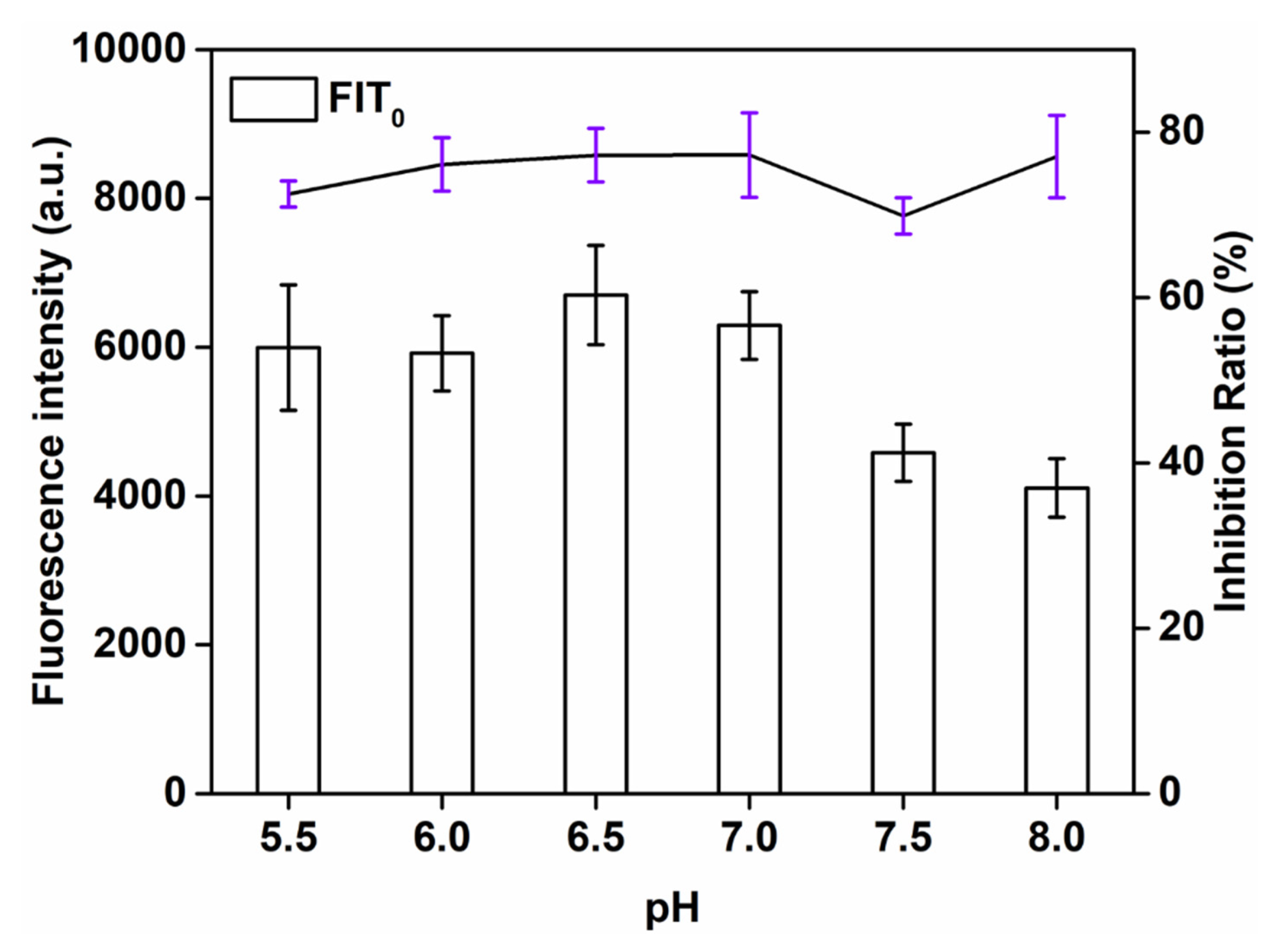

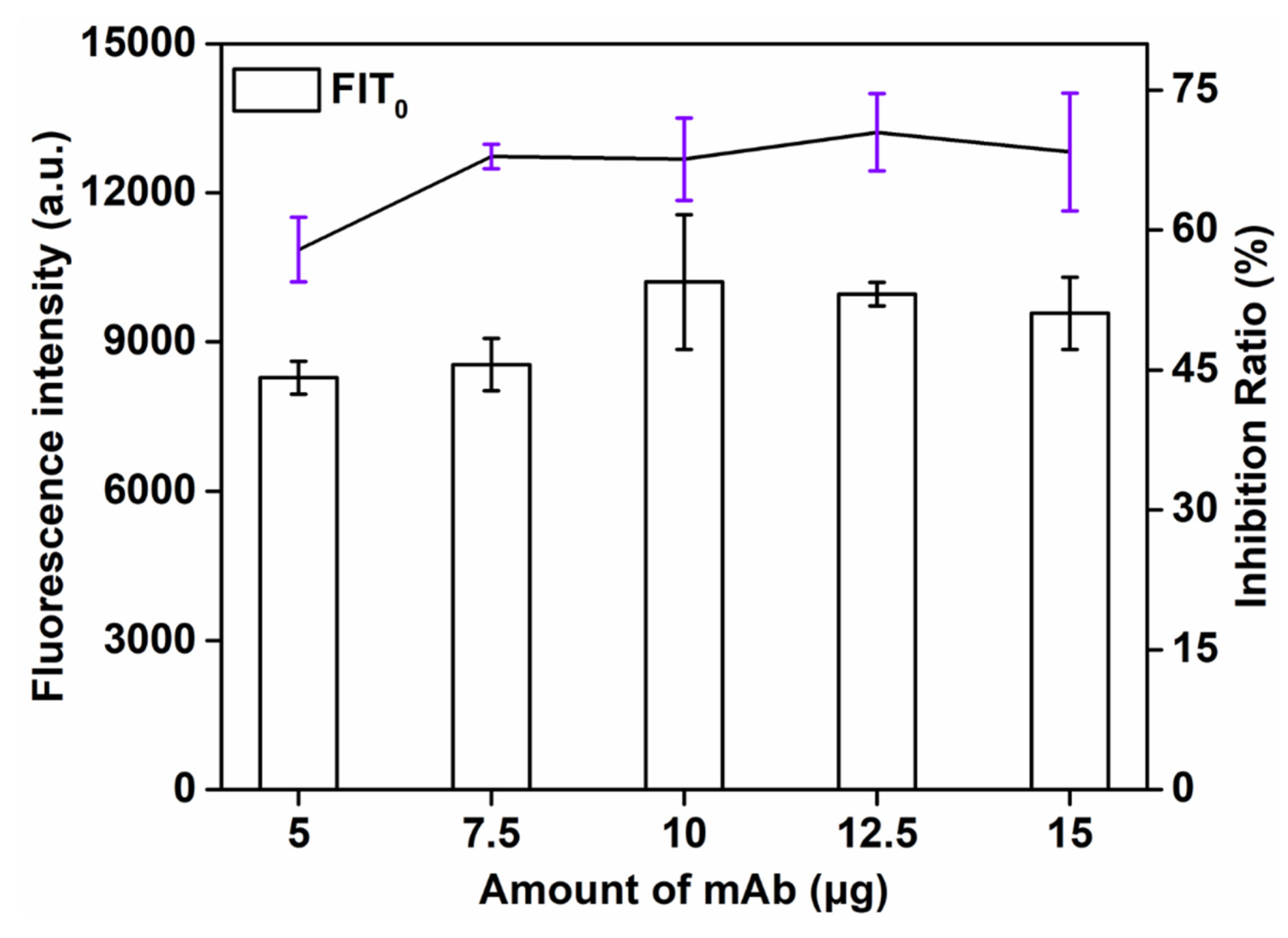




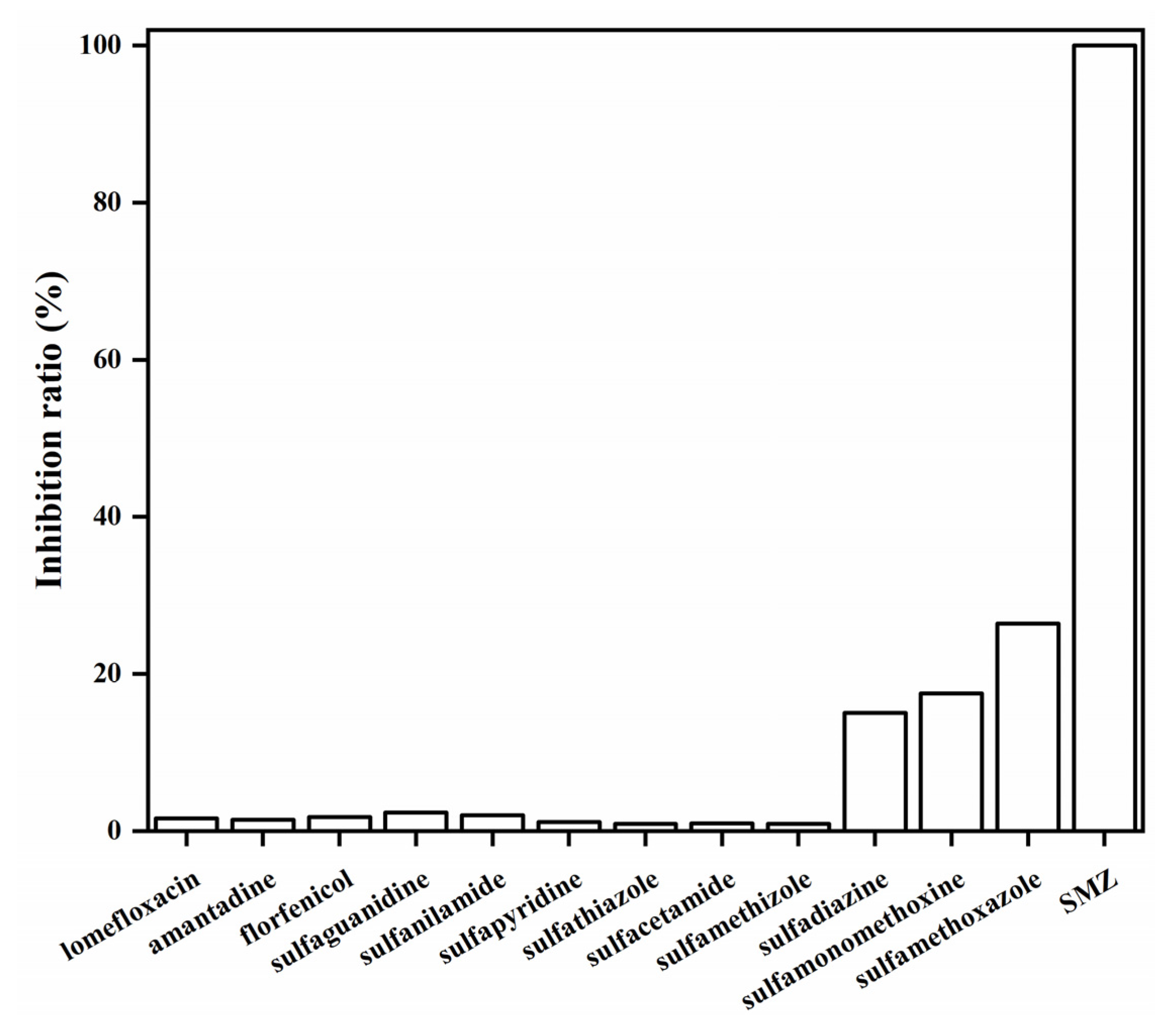
| Methods | Target | Detection Samples | Linear Range | LOD | Specificity | Reference | |
|---|---|---|---|---|---|---|---|
| Structure-Relative Compounds | Cross-Reactivity (%) | ||||||
| Traditional LFIA | SMZ | Meat and egg | - | 2 ng/mL | - | - | [23] |
| MI-ELISA | Swine muscle | 100–3200 μg/L | 6.8 ng/mL | Sulfapyridine | 3.1 | [6] | |
| Sulfadiazine | 5.0 | ||||||
| Sulfamerazine | 7.0 | ||||||
| Fluorescence polarization immunoassay (FPIA) | Milk | 5–58 ng/mL | 1.6 ng/mL | SMZ | 7.74 | [38] | |
| Sulfamerazine | 61.3 | ||||||
| Sulfamoxole | 415.98 | ||||||
| QBs-LFIA | Chicken | 0.2–12.5 ng/mL | 0.1138 ng/mL | SMZ | 15.5 | This work | |
| Sulfamonometh-oxine | 17.5 | ||||||
| Milk | 0.1–15 ng/mL | 0.0955 ng/mL | Sulfamethoxaz-ole | 26.4 | |||
| Sample | Spiked SMZ (ng/mL) | Recovery (%) a | Standard Deviation | CV (%) |
|---|---|---|---|---|
| Chicken | 0.5 | 80.9 | 3.94 | 4.88 |
| 5 | 88.8 | 4.78 | 5.39 | |
| 7.5 | 109.4 | 4.79 | 4.38 | |
| Milk | 0.5 | 84 | 5.44 | 6.48 |
| 5 | 101.6 | 11.5 | 11.32 | |
| 7.5 | 96 | 9.08 | 9.46 |
| Sample Number | QBs-LFIA (*100) | HPLC | Difference between QBs-LFIA and HPLC (%) | |
|---|---|---|---|---|
| 1 | Chicken | 2.07 | 228 | −9.21 |
| 2 | 1.7 | 184 | −7.6 | |
| 3 | 1.15 | 125 | −8 | |
| 4 | 0.79 | 82 | −2.56 | |
| 5 | 0.37 | 43.9 | −15.3 | |
| 6 | 0.157 | 13.72 | 14.6 | |
| 7 | ND | ND | ||
| 8 | ND | ND | ||
| 9 | Milk | 1.64 | 179.8 | −8.4 |
| 10 | 1.12 | 121.7 | −7.4 | |
| 11 | 1.18 | 120.5 | −1.7 | |
| 12 | 0.54 | 65 | −16.9 | |
| 13 | 0.51 | 60 | −15 | |
| 14 | 0.31 | 33 | −6 | |
| 15 | ND | ND | ||
| 16 | ND | ND |
Publisher’s Note: MDPI stays neutral with regard to jurisdictional claims in published maps and institutional affiliations. |
© 2021 by the authors. Licensee MDPI, Basel, Switzerland. This article is an open access article distributed under the terms and conditions of the Creative Commons Attribution (CC BY) license (https://creativecommons.org/licenses/by/4.0/).
Share and Cite
Wei, D.; Liu, J.; Wang, Z.; Zhou, S.; Wang, S.; Tong, W.; Peng, J. Quantum Dot Nanobeads Based Fluorescence Immunoassay for the Quantitative Detection of Sulfamethazine in Chicken and Milk. Sensors 2021, 21, 6604. https://doi.org/10.3390/s21196604
Wei D, Liu J, Wang Z, Zhou S, Wang S, Tong W, Peng J. Quantum Dot Nanobeads Based Fluorescence Immunoassay for the Quantitative Detection of Sulfamethazine in Chicken and Milk. Sensors. 2021; 21(19):6604. https://doi.org/10.3390/s21196604
Chicago/Turabian StyleWei, Daixian, Jintao Liu, Zexiang Wang, Shu Zhou, Suhua Wang, Weipeng Tong, and Juan Peng. 2021. "Quantum Dot Nanobeads Based Fluorescence Immunoassay for the Quantitative Detection of Sulfamethazine in Chicken and Milk" Sensors 21, no. 19: 6604. https://doi.org/10.3390/s21196604
APA StyleWei, D., Liu, J., Wang, Z., Zhou, S., Wang, S., Tong, W., & Peng, J. (2021). Quantum Dot Nanobeads Based Fluorescence Immunoassay for the Quantitative Detection of Sulfamethazine in Chicken and Milk. Sensors, 21(19), 6604. https://doi.org/10.3390/s21196604






